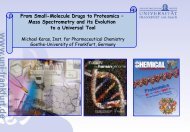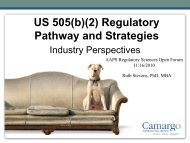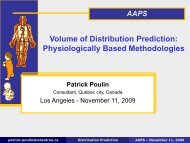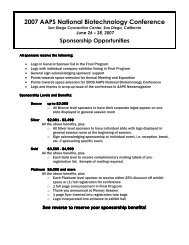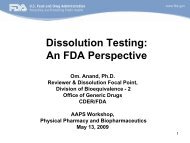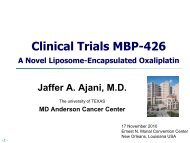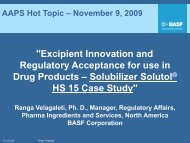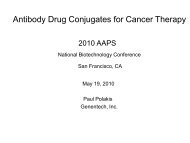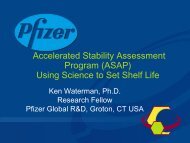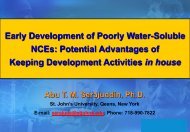Preliminary Program - American Association of Pharmaceutical ...
Preliminary Program - American Association of Pharmaceutical ...
Preliminary Program - American Association of Pharmaceutical ...
Create successful ePaper yourself
Turn your PDF publications into a flip-book with our unique Google optimized e-Paper software.
79<br />
2009 AAPS Annual Meeting and Exposition<br />
AAPS Regulatory Sciences (RS) <strong>Program</strong>ming<br />
TUESDAY AFTERNOON ROUNDTABLES<br />
Funded by a Grant from<br />
2:00 pm – 4:00 pm<br />
Stability Evaluations Using Alternate<br />
Accelerated Conditions<br />
Roundtable<br />
In the current environment, clinical materials<br />
are manufactured, packaged, tested, and<br />
distributed worldwide. During transition, there<br />
are inherent changes <strong>of</strong> degradation, physical<br />
stability, dissolution rate, and particle size that<br />
may be affected; thus increasing risk to clinical<br />
materials. This session will explore options to<br />
effectively maximize the data collected using<br />
predictive stability tools to support establishment<br />
<strong>of</strong> shelf-life for clinical materials and minimize<br />
the number <strong>of</strong> stability studies to support clinical<br />
program. This roundtable will discuss the use <strong>of</strong><br />
alternate accelerated/stress conditions, scientific<br />
understanding and predictive stability tools as an<br />
aid in the development to reduce risk and increase<br />
extrapolation robustness while maintaining<br />
product safety. Challenges to establish alternative<br />
accelerated conditions for unusual dosage forms<br />
and implication <strong>of</strong> physical and chemical changes<br />
on formulation/packaging and shipping strategies.<br />
Studies supporting shipment <strong>of</strong> clinical and<br />
commercial product, including controlling the<br />
shipment, monitoring and justifying excursions<br />
that may be observed.<br />
Moderators<br />
Kim Huynh-Ba, M.S.<br />
PHARMALYTIK<br />
Andrea Panaggio, Ph.D., M.S., R.Ph.<br />
Bristol-Myers Squibb<br />
Utilizing Stability and Analytical Tools to<br />
Improve Product Knowledge to Facilitate<br />
Support <strong>of</strong> a Global Clinical <strong>Program</strong><br />
Frank Diana, Ph.D.<br />
Endo <strong>Pharmaceutical</strong>s<br />
Formulation Development Study Strategies<br />
to Support Controlled Temperature Shipping<br />
Sailesh A. Varia, Ph.D.<br />
Bristol-Myers Squibb<br />
Stability Conditions for Product Development<br />
Evaluations Pre-IND to Assure Acceptable<br />
Product During Shipment and Storage<br />
Edward Koch<br />
McNeil Consumer Healthcare<br />
2:00 pm – 4:00 pm<br />
Bioequivalence Requirements:<br />
Challenges in Global Drug Development<br />
and Harmonization<br />
Roundtable<br />
The pharmaceutical drug industry has become<br />
increasingly global. Bioequivalence and<br />
interchangeability requirements for registration<br />
<strong>of</strong> multisource (generic) pharmaceutical products<br />
vary in each domestic market place. Harmonization<br />
<strong>of</strong> these requirements would decrease duplication<br />
<strong>of</strong> studies and unnecessary human drug exposure.<br />
This symposium will bring together pharmaceutical<br />
scientists from industry and regulatory agencies<br />
to review scientific and regulatory issues that would<br />
begin a process <strong>of</strong> harmonization <strong>of</strong> bioequivalence<br />
requirements. Some issues to be discussed will<br />
include the selection <strong>of</strong> a reference listed drug<br />
product; the design <strong>of</strong> bioequivalence studies both<br />
in vivo and in vitro approaches; and the acceptance<br />
criteria for bioequivalence.<br />
Moderators<br />
Leon Shargel, Ph.D.<br />
Applied Biopharmaceutics<br />
Raja Velagapudi, Ph.D.<br />
Barr <strong>Pharmaceutical</strong>s, Inc.<br />
International Bioequivalence Requirements<br />
Gordon Johnston, M.S.<br />
Generic <strong>Pharmaceutical</strong> <strong>Association</strong><br />
International Reference Listed Drug Product<br />
Leon Shargel, Ph.D.<br />
Applied Biopharmaceutics<br />
Harmonization <strong>of</strong> Bioequivalence<br />
Requirements<br />
Paul Fackler, Ph.D.<br />
Teva <strong>Pharmaceutical</strong>s<br />
Wednesday, November 11, 2009<br />
WEDNESDAY MORNING SYMPOSIA<br />
Funded by a Grant from<br />
8:30 am – 11:00 am<br />
The Influence <strong>of</strong> Excipient Functionality<br />
on Quality by Design for Drug Product<br />
Symposium<br />
Excipients facilitate manufacturing, enhance or<br />
support stability, and/or aid in vivo performance<br />
<strong>of</strong> a product. Certificates <strong>of</strong> analysis provide little<br />
information about what the industry has termed<br />
excipient functionality. This demands thorough<br />
understanding <strong>of</strong> material characteristics such<br />
as particle size and morphology, solid-state<br />
characterization and processing to name a few.<br />
Functionality has become a hot topic since the<br />
European Pharmacopoeia (EP) listed specific<br />
functionality-related characteristics (FRCs) in<br />
some <strong>of</strong> its excipient monographs. USP has looked<br />
into including a General Chapter on Excipient<br />
Performance Testing suggesting it could be part <strong>of</strong><br />
the labeling section and non-mandatory. Excipient<br />
manufacturers are voicing concerns because<br />
in their view functionality may mean different<br />
things to different people. The characterization <strong>of</strong><br />
functionality is very simply process understanding<br />
in accordance with the philosophy <strong>of</strong> the U.S. Food<br />
and Drug Administration (FDA), PAT and 21st century<br />
GMP initiatives. QbD is an approach to product<br />
development that seeks to find the limits within<br />
which acceptable product can be manufactured<br />
(edge <strong>of</strong> failure) and thereby the approvable design<br />
space. Standardized testing for excipients could<br />
play a critical role in the definition <strong>of</strong> design space<br />
and any quality-by-design endeavor must define<br />
the materials properly. There is a growing need for<br />
a systematic process to evaluate the interaction<br />
between components <strong>of</strong> a product to increase<br />
scientific understanding and correlation between<br />
physical and mechanical properties <strong>of</strong> materials<br />
and their functionality and ways in which the design<br />
space can be expanded by development <strong>of</strong> relevant<br />
functionality tests. This symposium will address<br />
the role the functionality tests <strong>of</strong> excipients will<br />
play in the QbD world through how we perform the<br />
functionality tests, how this test helps in establishing<br />
the design space, and the appropriate control<br />
strategies. A regulatory perspective will provide<br />
in-sight into this concept. In addition, the challenges<br />
and opportunities facing the excipient manufacturers<br />
and also the role <strong>of</strong> the pharmacopoeia as it pertains<br />
to supporting such changes will also be discussed as<br />
part <strong>of</strong> this symposium.



